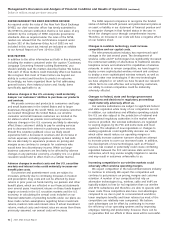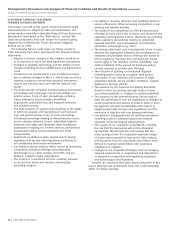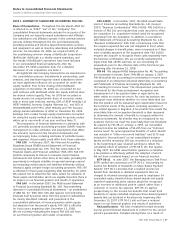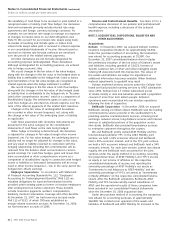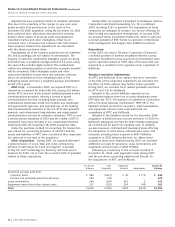AT&T Wireless 2007 Annual Report Download - page 60
Download and view the complete annual report
Please find page 60 of the 2007 AT&T Wireless annual report below. You can navigate through the pages in the report by either clicking on the pages listed below, or by using the keyword search tool below to find specific information within the annual report.
Notes to Consolidated Financial Statements (continued)
Dollars in millions except per share amounts
58
| 2007 AT&T Annual Report
integration activities following our December 2006 acquisition
of BellSouth, we revised our segment reporting in 2007 (see
Note 4).
Income Taxes As discussed previously in this footnote,
we adopted FIN 48 on January 1, 2007. Prior to our adoption
of FIN 48, we provided deferred income taxes for temporary
differences between the carrying amounts of assets and
liabilities for financial reporting purposes and the amounts
used for tax purposes. With our adoption of FIN 48, we provide
deferred income taxes for temporary differences between the
carrying amounts of assets and liabilities for financial reporting
purposes and the tax basis of assets and liabilities computed
pursuant to FIN 48. Under FIN 48, the tax bases of assets
and liabilities are based on amounts that meet the FIN 48
recognition threshold and are measured pursuant to the
measurement requirement in FIN 48. To the extent allowed
by GAAP, we provide valuation allowances against the
deferred tax assets for which the realization is uncertain.
We review these items regularly in light of changes in federal
and state tax laws and changes in our business.
Investment tax credits earned prior to their repeal by the
Tax Reform Act of 1986 are amortized as reductions in income
tax expense over the lives of the assets, which gave rise to the
credits. Additionally, we report taxes imposed by governmental
authorities on revenue-producing transactions between us
and our customers in the income statement on a net basis.
Cash Equivalents Cash and cash equivalents include all
highly-liquid investments with original maturities of three
months or less and the carrying amounts’ approximate fair
value. At December 31, 2007, we held $889 in cash and
$1,081 in money market funds and other cash equivalents.
Investment Securities Investments in securities principally
consist of available-for-sale instruments. Short-term and
long-term investments in money market securities are carried
as held-to-maturity securities. Available-for-sale securities
consist of various debt and equity securities that are long
term in nature. Unrealized gains and losses, net of tax, on
available-for-sale securities are recorded in accumulated other
comprehensive income. Our investment securities maturing
within one year are recorded in “Other current assets” and
instruments with maturities of more than one year are
recorded in “Other Assets” on the consolidated balance sheets.
Revenue Recognition Revenues derived from wireless, local
telephone, long-distance, data and video services are recognized
when services are provided. This is based upon either usage
(e.g., minutes of traffic processed), period of time (e.g., monthly
service fees) or other established fee schedules. Our wireless
service revenues are billed either in advance, arrears or are
prepaid. Our wireless Rollover® rate plans include a feature
whereby unused anytime minutes do not expire each month
but rather are available, under certain conditions, for future
use for a period not to exceed one year from the date of
purchase. Using historical subscriber usage patterns, we
defer these revenues based on an estimate of the portion of
unused minutes expected to be utilized prior to expiration.
We record an estimated revenue reduction for future
adjustments to customer accounts, other than a provision for
doubtful accounts, at the time revenue is recognized based on
historical experience. Service revenues also include billings to
our customers for various regulatory fees imposed on us by
governmental authorities. Cash incentives given to customers
are recorded as a reduction of revenue. When required as part
of providing service, revenues and associated expenses related
to nonrefundable, upfront service activation and setup fees
are deferred and recognized over the associated service
contract period. If no service contract exists, those fees are
recognized over the average customer relationship period.
Associated expenses are deferred only to the extent of such
deferred revenue. For contracts that involve the bundling
of services, revenue is allocated to the services based on
their relative fair value. We record the sale of equipment to
customers as gross revenue when we are the primary obligor
in the arrangement, when title is passed and when the
products are accepted by customers. For agreements involving
the resale of third-party services in which we are not
considered the primary obligor of the arrangement, we
record the revenue net of the associated costs incurred.
For contracts where we provide customers with an indefeasible
right to use network capacity, we recognize revenue ratably
over the stated life of the agreement.
We recognize revenues and expenses related to publishing
directories on the amortization method, which recognizes
revenues and expenses ratably over the life of the directory
title, typically 12 months.
Traffic Compensation Expense We use various estimates
and assumptions to determine the amount of traffic
compensation expenses recognized during any reporting
period. Switched traffic compensation costs are accrued
utilizing estimated rates by product, formulated from
historical data and adjusted for known rate changes and
volume levels. Such estimates are adjusted monthly to
reflect newly-available information, such as rate changes
and new contractual agreements. Bills reflecting actual
incurred information are generally not received until three
to nine months subsequent to the end of the reporting
period, at which point a final adjustment is made to the
accrued switched traffic compen sation expense. Dedicated
traffic compensation costs are estimated based on the
number of circuits and the average projected circuit costs.
These costs are adjusted to reflect actual expenses over
the three months following the end of the reporting period
as bills are received.
Allowance for Uncollectibles We maintain an allowance
for doubtful accounts for estimated losses that result from
the failure or inability of our customers to make required
payments. When determining the allowance, we consider
the probability of recoverability of accounts receivable based
on past experience, taking into account current collection
trends as well as general economic factors, including
bankruptcy rates. Credit risks are assessed based on historical
write-offs, net of recoveries, as well as an analysis of the
aged accounts receivable balances with reserves generally
increasing as the receivable ages. Accounts receivable may
be fully reserved for when specific collection issues are
known to exist, such as pending bankruptcy or catastrophes.
The analysis of receivables is performed monthly, and the
bad-debt allowances are adjusted accordingly.
Inventory Inventories are included in “Other current
assets” on our consolidated balance sheet and were $1,119
and $756 at December 31, 2007 and 2006, respectively.
Wireless handsets and accessories, which are valued at the
lower of cost or market value (determined using current
replacement cost) amount to $836 and $467 for the years
2007 and 2006. The remainder of our inventory includes new




